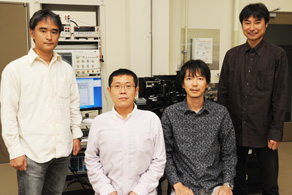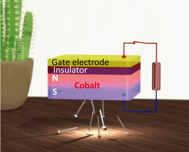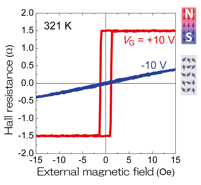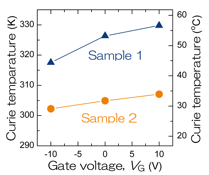Assist. Prof. Chiba, Prof. Ono, Assoc. Prof. Kobayashi and Mr. Shimamura ”Electrical Control of Ferromagnetic Phase Transition in Cobalt at Room Temperature” (Published in “Nature Materials,” 2 October 2011)
|
Assist. Prof. Chiba, Prof. Ono, Assoc. Prof. Kobayashi and Mr. Shimamura (Nanospintronics, Division of Materials Chemistry)
Electrical Control of Ferromagnetic Phase Transition in Cobalt at Room Temperature
Published in ” Nature Materials“(Online Publication, Oct 3, 2011). |
 From left: Assoc. Prof. Kobayashi, Mr. Shimamura, Assist. Prof. Chiba and Prof. Ono |
||
|
Electrical control of magnetic properties is crucial for device applications in the field of spintronics. A research team consists of assistant professor Daichi Chiba, professor Teruo Ono, associate professor Kensuke Kobayashi, and Mr. Kazutoshi Shimamura (D2) at Institute for Chemical research, and NEC cooperation demonstrate the room-temperature electrical control of the ferromagnetic phase transition in cobalt, one of the most representative transition-metal ferromagnets. Solid-state field effect devices, consisting of a ultra-thin cobalt film covered by a dielectric layer and a gate-electrode on top of that, were fabricated (Fig. 1). Gate voltages were applied between the cobalt layer and the gate electrode. The results under applied gate voltage (VG) of ±10 V are shown in Fig. 2. A clear change from a square loop (ferromagnetic curve) at VG= +10 V to a linear response (paramagnetic curve) with no coercivity at –10 V was observed. We prove that the Curie temperature of cobalt can be changed up to 12 K by applying VG of ±10 V (Fig. 3). The result is a significant development for future low-power magnetic devices at room temperature. For example, it could be used for “field-effect magnet”, where the magnet can be easily switched-off to a non-magnet electrically, and for non-dissipative magnetic force generator without electric current. In addition, the demonstrated electric field effect of the two dimensional ferromagnetism opens up a new way to explore and control the magnetism in terms of the dimensionality. |
|||

|
Fig. 1 Ferromagnetic phase transition of a metal ferromagnet of Cobalt (Co) was induced by applying a gate voltage (VG) at room temperature. The device for the transport measurements consists of a metal gate (Au/Cr), an insulator layer (HfO2), and an ultra-thin Co layer. |
||
|
Fig. 2 The curves of the Hall resistance measured by sweeping an external magnetic field under applied VG of ±10 V. Hall resistance is proportional to magnetization because of the anomalous Hall effect. |

|
||

|
Fig. 3 Curie temperatures as a function of gate voltage. |
||
| The article, ” Electrical control of ferromagnetic phase transition in cobalt at room temperature ” by Daichi Chiba, Shunsuke Fukami, Kazutoshi Shimamura, Nobuyuki Ishiwata, Kensuke Kobayashi, and Teruo Ono was published online in the October 2, 2011 issue of Nature Materials. | |||
| Acknowledgements: This work was partly supported by the PRESTO program from JST. | |||
| Link to the journal paper: http://dx.doi.org/10.1038/nmat3130 D. Chiba, S. Fuikami, K. Shimamura, N. Ishiwata, K. Kobayashi, and T. Ono, Electrical control of ferromagnetic phase transition in cobalt at room temperature. Nat Mater. 2011 Oct 2. doi: 10.1038/nmat3130. |
|||
 Institute for Chemical Research, Kyoto University
Institute for Chemical Research, Kyoto University International Joint Usage Research Center
International Joint Usage Research Center